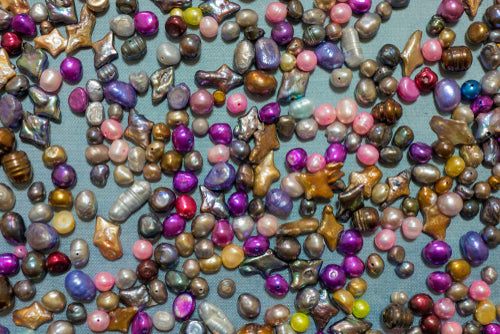
Freshwater Pearls: A Buyers’ Guide
Pearls are one of the most beloved types of beads for necklaces, bracelets and earrings. Part of their charm and allure has to do with the fact that these beads are created in nature and yet they have such a delicate, smooth appearance that almost looks handcrafted. If you’re hoping to begin working with pearls, you’ll want to learn more about why people gravitate towards freshwater pearls over saltwater and how to find the best colors and shapes to incorporate into your jewelry-making.
How Are Freshwater Pearls Created?
The process of pearl formations is rather complicated, but essentially, muscles grow these beautiful little beads over time through a process called nucleation. When something is inserted or enters a muscle, the shell reacts by trying to cover the irritant with a natural secretion called nacre. This coating released by the mollusk is actually the pearl that we know and love. After the pearls have been harvested, they can be turned into unique jewelry pieces.
Freshwater Pearls vs. Saltwater Pearls
Freshwater pearls tend to be favored by most jewelry makers and wearers because there is so much variety in their shape, size and color. The biggest difference in how these pearls are formed has to do with the environment. Freshwater pearls are created by muscles, which can be found in bodies of freshwater like lakes and rivers, while saltwater pearls are grown inside oysters found in the ocean. Because pearls are formed as a reaction to an irritant inside the mollusk, virtually all pearls that you find are cultured, meaning they were not formed as a result of a natural reaction. Most pearl farms will insert a bit of tissue or a small bead into the shell to help jumpstart the process of secreting nacre and forming a new, beautiful pearl. The size and shape of the inserted bead can alter the shape of the pearl, which is how coin pearls are formed.
Freshwater pearls are praised for their greater variety in appearance though they tend to be smaller than saltwater pearls. Saltwater pearls typically form only in the standard circular shape and often have a more polished look.

What Are the Most Favored Colors and Shapes?
Freshwater pearls are an excellent choice for jewelry-making because they are each so unique and can be found in many shapes and sizes. This brings a new dimension to your jewelry and makes every piece truly one-of-a-kind. Coin pearls are small circles with a flattened look and can be purchased in different colors to give your jewelry a little pop. Because nearly all of the world’s pearls—saltwater and freshwater—must be cultivated, the coin pearl is formed by inserting a specific-sized nucleus into the shell, causing the nacre to form in this unique shape.
Baroque pearls are another popular shape choice. This term simply refers to pearls that are not perfectly circular in shape, giving the beads their own individual appearance. This type of freshwater pearl is beautiful and can be found in non-traditional shapes like teardrops, eggs and even hearts, though this shape must be carefully cultivated.
Freshwater pearls can be purchased in a variety of colors as well—some naturally occurring, others dyed. Though an off-white, cream or silver is the most commonly produced natural pearl color, you can find natural pearls in shades of lavender and peach. Other popular colors include blues, greens and pinks, but these colors are achieved by adding an organic dye to the pearl. If you’re looking to achieve a specific color pattern in your jewelry, these colored pearls still offer a beautiful addition to any piece.
What to Look for in a Pearl
Before selecting your freshwater pearls, you should keep a few things in mind. Because of the way freshwater pearls are cultivated, there will always be discrepancies in the pearls’ appearance, which is part of the appeal, making each bead unique. However, to create a beautiful finished product, you should try to purchase pearl beads of similar sizes and shapes, giving the jewelry a consistent look.
How to Know if It’s Authentic
With the widespread cultivation of both freshwater and saltwater pearls, it’s not likely that you’ll run into many fake pearls, but it’s good to know how to identify the real from the counterfeit. Purchasing from a reputable source like The Bead Traders typically guarantees authenticity, but the most common way to test is by rubbing the front of your tooth against the pearl. If it feels gritty, it’s real.

Create Your Own Jewelry with Freshwater Pearls
The Bead Traders has a large selection of coin pearls and other unique shapes. If you’re looking to create a truly unique piece of jewelry, try incorporating this naturally formed bead. Keep in mind the colors of freshwater pearls and how you can work these into your design for a charming, delicate finished product.


